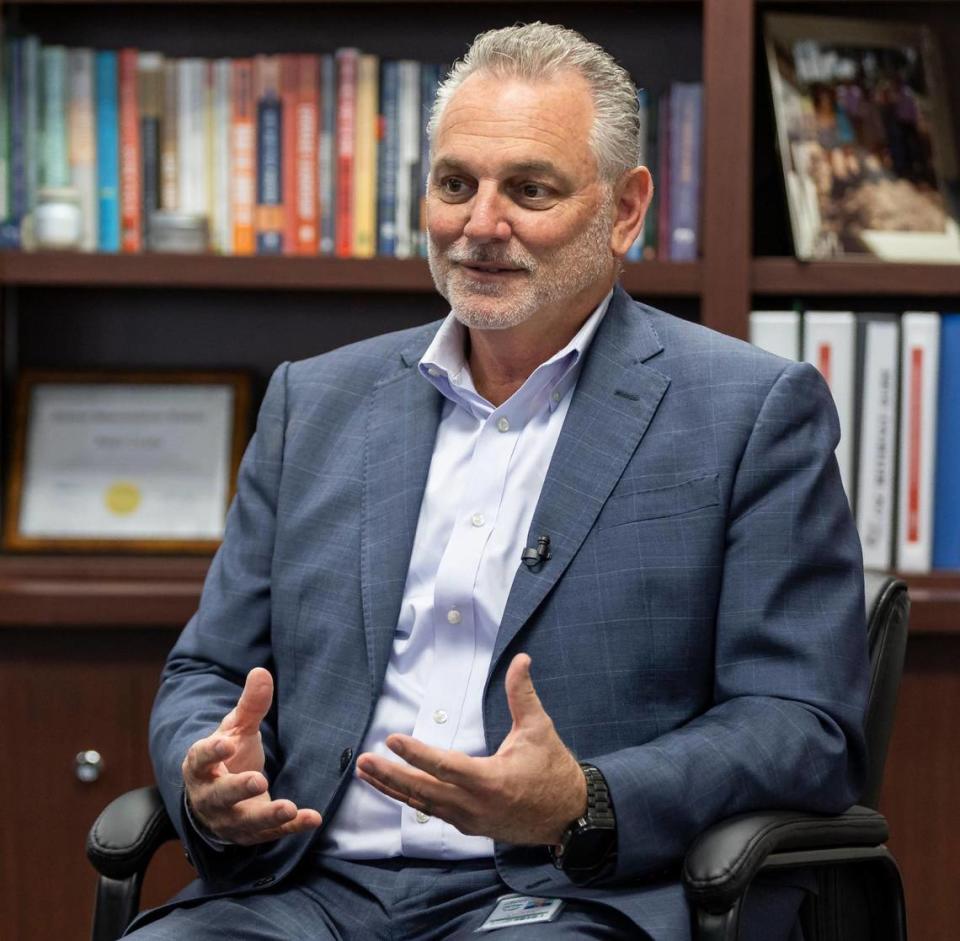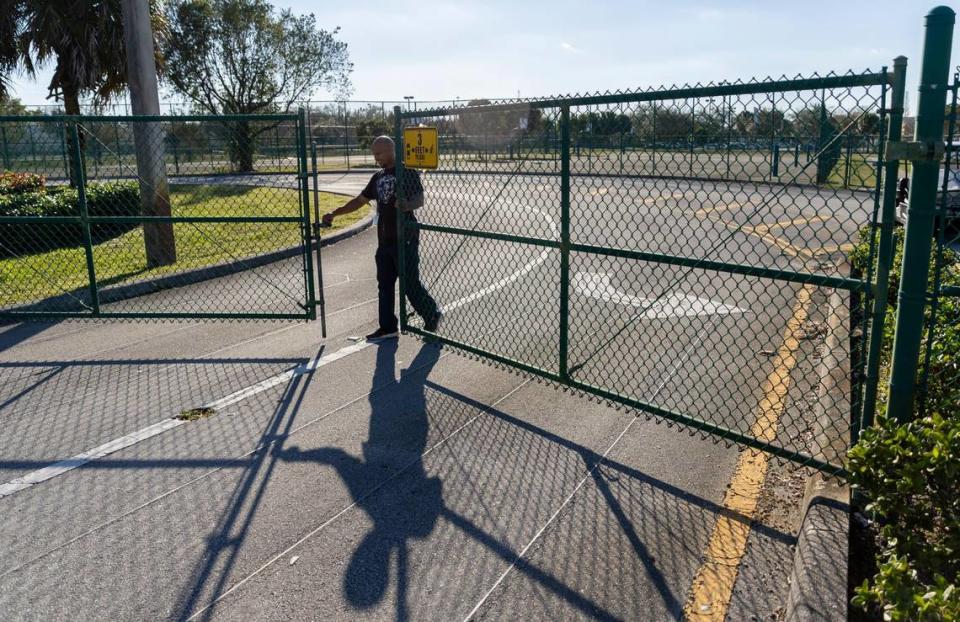Broward superintendent discusses the options as district explores closing schools
About four years ago, Walnite Denis moved from Miami Gardens to Pembroke Pines for her daughters.
“I moved to Broward to make sure they go to a good school,” the Haitian immigrant said.
Her eldest now attends Pines Middle School at 200 Douglas Rd., and her youngest goes to Palm Cove Elementary School at 11601 Washington St. They’re both gifted students.
She loves their schools, so she raised her eyebrows in surprise when she found out this week that one of them, Pines Middle, is one of the 67 most under-enrolled public schools in Broward County, possibly meaning the school district could close it or re-purpose it in coming months. Currently, Pines Middle has the capacity for 1,769 students, but it’s missing 1,159 students — it’s operating at a measly 34.5%.
Denis is exactly the type of person Broward Schools Superintendent Peter Licata wants to meet, as he and his administration embark on one of the most challenging missions the school district has faced in years: close or re-purpose at least five out of its total 239 schools in the 2025-26 school year. Broward schools is currently missing about 51,000 students, and the projections are bleak.
In total, 67 out of the total 239 schools in Broward — or 28% — are operating at 70% of their capacity or less.
“If you ask superintendents around the country, it’s something they never want to do. It’s incredibly challenging. But I can’t look at it negatively; I want to look at it as an opportunity,” Licata told the Herald in a recent interview. “It may not seem like an opportunity, but it is one. Remember, if we’re spending money on things we don’t have — like students — it takes away from teachers and bus drivers and cafeteria workers and others.”
To hear opinions from parents, students, employees, business owners and others, the Broward school district will hold three town halls this month, open to anyone in the community:
6 p.m. Thursday, February 8, 2024 at the Fort Lauderdale High School at 1600 NE 4th Ave. in Fort Lauderdale
6 p.m. Thursday, February 15, 2024 at the J.P. Taravella High School at 10600 Riverside Dr. in Coral Springs
6 p.m. Thursday, February 22, 2024 at the Charles W. Flanagan High School at 12800 Taft St. in Pembroke Pines
All meetings will be live streamed at www.becon.tv/redefining. The school district will also put out surveys to gather input.
Why are students leaving and what are the options?
If you ask the top official at the Broward school district why families are fleeing his public schools, he will point to myriad reasons — and none for certain at the same time. Most leave from kindergarten to third grade, or from sixth to eighth grade, he said.
Families could have pulled students because they have opted for home-schooling instead, switched to charter or private schools, or moved out of the county or state because of the rising cost of living. They could’ve also done it because they were seeking a specific magnet program at another school, because they disliked the staff or because the state-granted grade fell for that school. The county’s shrinking birth rate, controversial state politics and the lack of families moving to Broward could also be triggering it.
All of that could be affecting the enrollment at Broward Public Schools, but he won’t know for sure until he speaks to the people directly involved, he said. That’s why he refuses to put out a list of schools he’s considering affecting, because he wants to keep an open mind.
“There is no written list. There will be none. We all have something in our heads. We’ve looked at schools. But if we do that we’ve already tanked the process,” he said.
He also wants to keep his options open. For Licata, “close” or “re-purpose” aren’t the only changes he could implement.
The district could also combine two under-enrolled schools to create an at-capacity elementary school or a K-8 center or 6-12 center.
The district could convert part of a school to provide another service, like a technical education or special education, medical or dental health care, workforce training, youth programming or recreational activities.
It could also lease or sell a property to address other needs, like affordable housing for underpaid teachers and others.
And it could also change the school attendance zone by adding or removing neighborhoods assigned to a specific school.
If a school does close, the district will re-assign students to another. Bargaining agreements with teachers and other groups will mandate what happens to the employees of a school that closes; they will likely fill in the gaps at another schools or follow students if a school combines.
In order to decide what to do ultimately, Licata intends to rely on data — data like the list of the 67 under-enrolled schools currently using less than 70% of their capacity, enrollment numbers for surrounding private and charter schools, enrollment projections, academic performance and facilities’ status.
For more information, click here.
The timeline, sensitivity the superintendent foresees
Because he already faced a controversial move during his tenure since the summer, Licata wants to get this right.
In December, the Broward School Board killed a proposal to start its own police force after the public strongly rejected it.
That’s why with the “re-defining” of schools, as he calls it, Licata wants to be intentional. He’s allotting about 18 months for the process to play out and keeping in mind it’ll be a sensitive topic because it may involve changing historical facilities, boundaries and family traditions.
Alongside the February town halls, Licata will gather with city mayors and managers, county commissioners and other public officials to get their feedback.
He will also reach out to leaders of places of worship.
“Places of worship are very important for communities. They’re places where you can get authentic feedback. And a lot of the traditions in history exist in places of worship, and in this county, there are a lot of traditions, and historical names and facilities that we really want to make sure we respect as we move through,” Licata said. “We can’t just go into neighborhoods, and tell them, ‘Yeah, we own the property.’ Everyone owns the property so we want to be very sensitive to the community. That’s why we want to listen to them.”
On March 20, Licata plans to meet with the Broward School Board to get more direction. He also scheduled another board workshop for May 14.
He doesn’t “foresee” taking any decision that impacts students in the 2024-25 school year, he said. Instead, he said the district will focus on selling excess land and if needed, changing boundary limits, which he’s “99.9%” sure he’ll need to do.
In the 2025-26 school year, the district would affect at least five schools, which he said could be painful.
“The schools belong to the community, and they’re historical places,” Licata said. “If all of a sudden we say, ‘Hey, we’re closing this school,’ people go, ‘Wait a minute, I went here. My mother went here. My kids go here. That’s where they’re supposed to go, how could you do this?’ That’s the sensitive part of it.”
“We learned a lot when we brought up the potential police force,” he added. “We learned we need to communicate even more. So our goal is that nobody, nobody, in 18 months is able to say, ‘I didn’t know about this.’”
A previous version of this story incorrectly indicated the Broward School Board considered clear backpacks under Superintendent Peter Licata’s tenure. The board considered that rule before he took over the school district.


